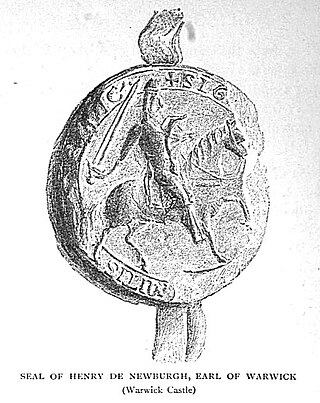
Earl of Warwick is one of the most prestigious titles in the peerages of the United Kingdom. The title has been created four times in English history, and the name refers to Warwick Castle and the town of Warwick.

Henry de Beaumont, 1st Earl of Warwick or Henry de Newburgh was a Norman nobleman who rose to great prominence in the Kingdom of England.

Earl of Worcester is a title that has been created five times in the Peerage of England. Worcester is a cathedral city in Worcestershire, England.

Earl of Surrey is a title in the Peerage of England that has been created five times. It was first created for William de Warenne, a close companion of William the Conqueror. It is currently held as a subsidiary title by the Dukes of Norfolk.

William de Warenne, 2nd Earl of Surrey was the son of William de Warenne, 1st Earl of Surrey and his first wife Gundred. He was more often referred to as Earl Warenne or Earl of Warenne than as Earl of Surrey.

William de Warenne, 5th Earl of Surrey was the son of Isabel de Warenne, 4th Countess of Surrey and Hamelin de Warenne. His father Hamelin granted him the manor of Appleby, North Lincolnshire.
Elizabeth of Vermandois, was a French noblewoman, who by her two marriages was the mother of the 1st Earl of Worcester, the 2nd Earl of Leicester, the 3rd Earl of Surrey, and of Gundred de Warenne, mother of the 4th Earl of Warwick.

Waleran de Beaumont (1104–1166) was an Anglo-Norman nobleman. In his early adulthood, he was a member of the conspiracy of Amaury III of Montfort; later in his career, he participated in the Anarchy and the Second Crusade. During the reign of Henry II of England, Waleran's close ties to Louis VII of France caused him to fall out of grace.
Roger de Beaumont, 2nd Earl of Warwick was the elder son of Henry de Beaumont, 1st Earl of Warwick and Margaret, daughter of Geoffroy, Count of Perche and Beatrix of Montdidier. He was also known as Roger de Newburgh.

Henry de Beaumont, 5th Earl of Warwick, Earl of Warwick, and by marriage Lord of Hocknorton and Hedenton (Headington) in Oxfordshire, was the son of Waleran de Beaumont, 4th Earl of Warwick and Margaret de Bohun. He was also known as Henry de Newburgh.
William Mauduit, 8th Earl of Warwick or William Maudit was an English nobleman and participant in the Second Barons' War.
Roger Fitzmiles, 2nd Earl of Hereford, was an English noble who played an active and influential part in the wars between Empress Matilda and King Stephen.
The title Countess of Warwick may be given either to a female heir of the Earl of Warwick or to the wife of the Earl of Warwick. The title has been held by several women, including:

William de Beaumont, 3rd Earl of Warwick was an English nobleman. He was married to Matilda de Percy, daughter of William de Percy and his first wife Alice of Tonbridge.
David Bruce Crouch, is a British historian and academic. From 2000 until his retirement in 2018, he was Professor of Medieval History at the University of Hull.
Reginald de Warenne was an Anglo-Norman nobleman and royal official. The third son of an earl, Reginald began his career as an administrator of his brother's estates and continued to manage them for his brother's successor, William, the second son of King Stephen. Reginald was involved in the process that led to the peaceful ascension of Henry fitzEmpress to the throne of England in 1154 and served the new king as a royal justice afterwards. He played a minor role in the Becket controversy in 1170, as a member of the party that met Becket on his return to England from exile in 1170.

Ela Longespée, Countess of Warwick was an English noblewoman. She was the daughter of Ela of Salisbury, 3rd Countess of Salisbury and William Longespée, and sister to, among others, Nicholas Longespee, Bishop of Salisbury. Ela married, first, Thomas de Beaumont, 6th Earl of Warwick, and, secondly, Philip Basset. She was a great religious benefactor, and contributed to the foundation of Merton College, Oxford.

Philippa Basset, Countess of Warwick, was a 13th-century noblewoman and heiress. She was the wife firstly of Henry (II) de Newburgh, earl of Warwick and after his premature death she was married to Richard Siward a soldier and adventurer at the court of King Henry III of England.

Matilda de Percy, Countess of Warwick, was a 12th-century noblewoman and heiress. She was the wife of William, earl of Warwick and, in 1174 became a co-heir of her father's large Yorkshire barony with her younger sister Agnes.

Gundreda de Warenne, Countess of Warwick was the wife of Earl Roger. She was the daughter and eldest child of William II, earl Warenne by the Capetian princess Isabel of Vermandois daughter of Count Hugh the Great of Vermandois and niece of King Philip I of France. On the death of her first husband Count Robert of Meulan and Leicester in 1118 Isabel promptly married Earl William II de Warenne and since Gundreda had an infant daughter by 1138 it is most likely she was the eldest child of the marriage. The Flemish name Gundreda was given her in recollection of her father's mother Gundreda de Warenne.







